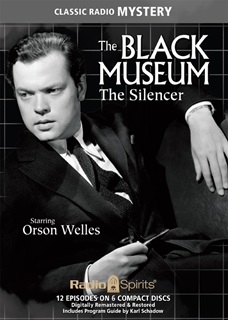
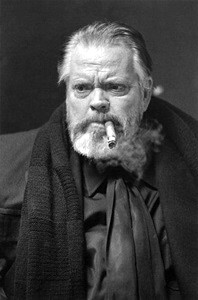 “The Black Museum. A Repository of Death. Here in the grim stone structure on the Thames which houses Scotland Yard is a warehouse of homicide, where everyday objects . . . all are touched by murder.”
“The Black Museum. A Repository of Death. Here in the grim stone structure on the Thames which houses Scotland Yard is a warehouse of homicide, where everyday objects . . . all are touched by murder.”
The Black Museum (1952) aired “The Pink Powder Puff” (in the United States and as near as historians can reasonably ascertain) on August 5, 1952, as the 32nd of the show’s 51 episodes. This is the 11th episode we’ve run of the show since 2018 and only the second since September of 2021, 3 years ago, so a bit of background is in order for newcomers to this sometimes grisly program. First of all, the name the Black Museum was coined in 1877 by a reporter for London’s The Observer newspaper, though the museum had opened in 1875 with the official name of simply the Crime Museum. It is the oldest museum in the world to display only artifacts of crime and is still known today by its official name of the Crime Museum despite the more colorful name given it by The Observer. The museum is not open to the public and is used primarily for instructional purposes for police training, but has had special visitors the likes of Sir Arthur Conan Doyle.
The Black Museum was one of four similar shows produced by Harry Alan Towers (1920-2009) under his Towers of London label in the late 1940s and early 1950s. Towers, a native born Britisher, would also produce popular radio fare like Secrets of Scotland Yard, Fabian of the Yard, and WHItehall 1212. All four shows centered around stories from the files of Scotland Yard, and New Scotland Yard’s famous Crime Museum, which was popularized in crime novels as the Black Museum. While all but Fabian of the Yard are verified as being produced and syndicated in Britain for future syndication, it is interesting to note that, according to the Digital Deli Too website entry, “WHItehall 1212 was a National Broadcasting Corporation production written by Lights Out’s famous scriptwriter Wyllis Cooper….” Three of the four shows, The Black Museum among them, would wrap their stories around an artifact from the museum, recounting in dramatic form the infamous crime associated with said artifact. Secrets of Scotland Yard kept to historical facts quite closely, and while a fascinating listen and quite popular, didn’t have the flair or melodramatic effect the likes of Orson Welles (1915-1985) would bring to The Black Museum as the host and narrator of each of its 51 episodes. And while The Black Museum also kept to the historical record surrounding each case, it would play a little fast and loose with them (or perhaps embellish them is the proper word) for dramatic effect, and it didn’t hurt that the show–unlike the others–drew its material solely from murders, thus guaranteeing the audience a chilling half hour. Overlay the grim stories with the somber, virtually hypnotic tones of Orson Welles and you’ve got a winner.
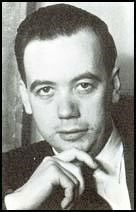
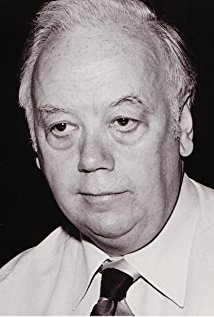 Speaking of Orson Welles, one might be given to wonder how he came to write some of, and host and narrate all of the episodes of The Black Museum, which were produced in the UK. It seems that Welles decided to take an extended “vacation” in England due to several professional and personal problems, including some “requests” from the Internal Revenue Service. So the American loss turned into Harry Alan Towers’s gain (Towers’s photo at left 1948, at right circa 1984), and he set Welles to work, a profitable solution for both parties. Welles would also work on two other Towers productions, perhaps the most well known to the American radio audience being The Lives of Harry Lime (or The Third Man.) The Third Man was a 1949 film noir British production set in post-World War II Vienna, with Welles playing the Lime character. Written by Graham Greene, it has attained classic status for its stylish portrayal of a decaying and corrupt Vienna, so Towers was striking while the iron was hot and rode the coattails of the film with Welles starring in the radio adaptation.
Speaking of Orson Welles, one might be given to wonder how he came to write some of, and host and narrate all of the episodes of The Black Museum, which were produced in the UK. It seems that Welles decided to take an extended “vacation” in England due to several professional and personal problems, including some “requests” from the Internal Revenue Service. So the American loss turned into Harry Alan Towers’s gain (Towers’s photo at left 1948, at right circa 1984), and he set Welles to work, a profitable solution for both parties. Welles would also work on two other Towers productions, perhaps the most well known to the American radio audience being The Lives of Harry Lime (or The Third Man.) The Third Man was a 1949 film noir British production set in post-World War II Vienna, with Welles playing the Lime character. Written by Graham Greene, it has attained classic status for its stylish portrayal of a decaying and corrupt Vienna, so Towers was striking while the iron was hot and rode the coattails of the film with Welles starring in the radio adaptation.
The airing of The Black Museum episodes presents problems for historians. Produced in 1950, it was first aired as a “pirate broadcast” by Radio Luxembourg, and then throughout Europe. It was eventually licensed by MGM Radio Attractions and ran in the United States under the Mutual Broadcasting System (MBS). MGM hand-picked what it considered to be the best 39 of the original 51 episodes and ran them from January 1, 1952 through December 30, 1952 (with a three month hiatus while a summer replacement filled the gap). This is the run from which we have taken “The Pink Powder Puff.” There’s more to the odd packaging and eventual airing of select episodes of The Black Museum (Canada’s CBC radio would also purchase some 38-39 episodes and air them at different times than the American run, for but one example), but all of that is neither here nor there for our current purposes.
“The Pink Powder Puff,” resting lightly on its small square of shelf and ringed by dust rarely disturbed, is the only evidence, a dark reminder of a military vet, a sad soul who chose to live the remainder of his life in the civilian world by exaggerating, lying about his military service in order to curry favor with a string of emotionally gullible women who believed, to their regret, his well rehearsed con. Listen now to this tragic, yet all too familiar story to discover the role “The Pink Powder Puff” played to earn its place of dishonor in a seldom visited corner of the Black Museum.
(The CD linked at top includes this episode and 11 others, all digitally remastered and restored, and features a program guide by old time radio historian and friend to this weekly Tangent feature Karl Schadow.)
Play Time: 29:34
{“The Pink Powder Puff” aired on a Tuesday evening in early August of 1952. A dark and gloomy tale to be sure, the neighborhood gang had had enough of the emotions it evoked, so after school the following day they found themselves at the nearby newsstand searching for more exciting, uplifting material, which they found in abundance in the magazines they soon carried home. Astounding Science Fiction (1930-present, now Analog) had become one of their favorites, and this issue (despite the rather bland cover) proved why. It carried two novelettes, one shown on the cover by Thomas Wilson, and the other by someone whose name I am not familiar with, M. C. Pease. It also contained two short stories by authors very familiar to most SF fans, Walter M. Miller, Jr. and Mark Clifton. So a fine issue of ASF was to be had, soon to be shared with the rest of the gang. ASF was a monthly in 1952. The Magazine of Fantasy & Science Fiction (known simply as F&SF, 1949-present) was still in its infancy from its lone debut issue in late 1949, and was still splitting its fiction between classic reprints and new stuff. The March 1954 issue of F&SF was its last to feature reprints, the April issue proclaiming on its cover “Every story in this issue NEW.” F&SF began as a quarterly at the end of 1949, became a bimonthly in December of 1951, and with the August 1952 issue shown below became a monthly. The issue below sported no fewer than 11 original short stories, several of which were written by such as Alfred Bester, L. Sprague de Camp and Fletcher Pratt, August Derleth, Gordon R. Dickson, Mildred Clingerman, and Graham Greene. Raymond Palmer began Other Worlds Science Stories (1949-53) as a counterpart to his primary non-fiction magazine Fate, which focused on UFOs and unexplained phenomena. It shortened its name to simply Other Worlds with the November 1952 issue. Not considered a major player in the SF magazine field during its relatively brief lifespan, it nevertheless attracted some name talent here and there, a few of whom were Walter M. Miller, Jr., Daniel Keyes, Sam Merwin, Jr., Jerome Bixby and James Blish, Mack Reynolds, and Eric Frank Russell. It managed 9 irregular issues in 1952.}
[Left: Astounding SF, 8/52 – Center: F&SF, 8/52 – Right: Other Worlds, 8/52]
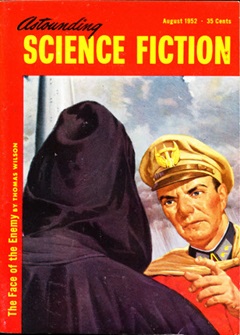
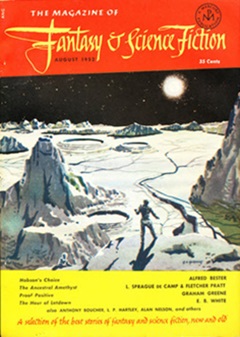
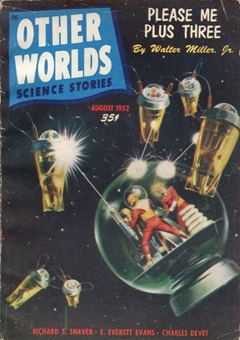
To view the entire list of weekly Old Time Radio episodes at Tangent Online, click here.